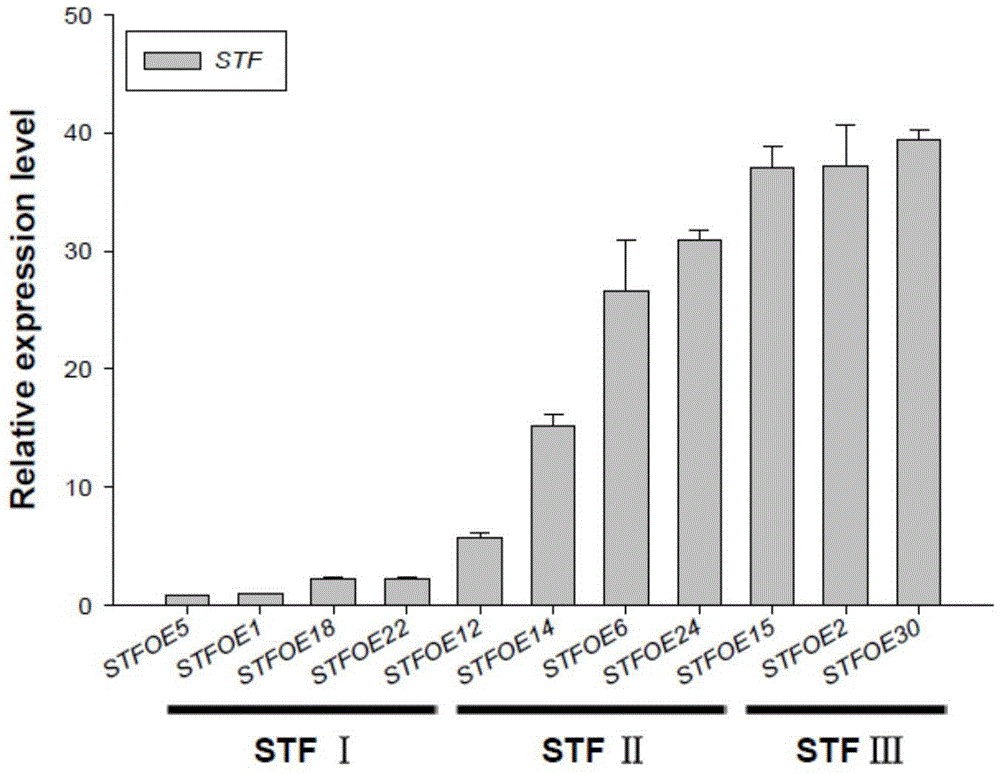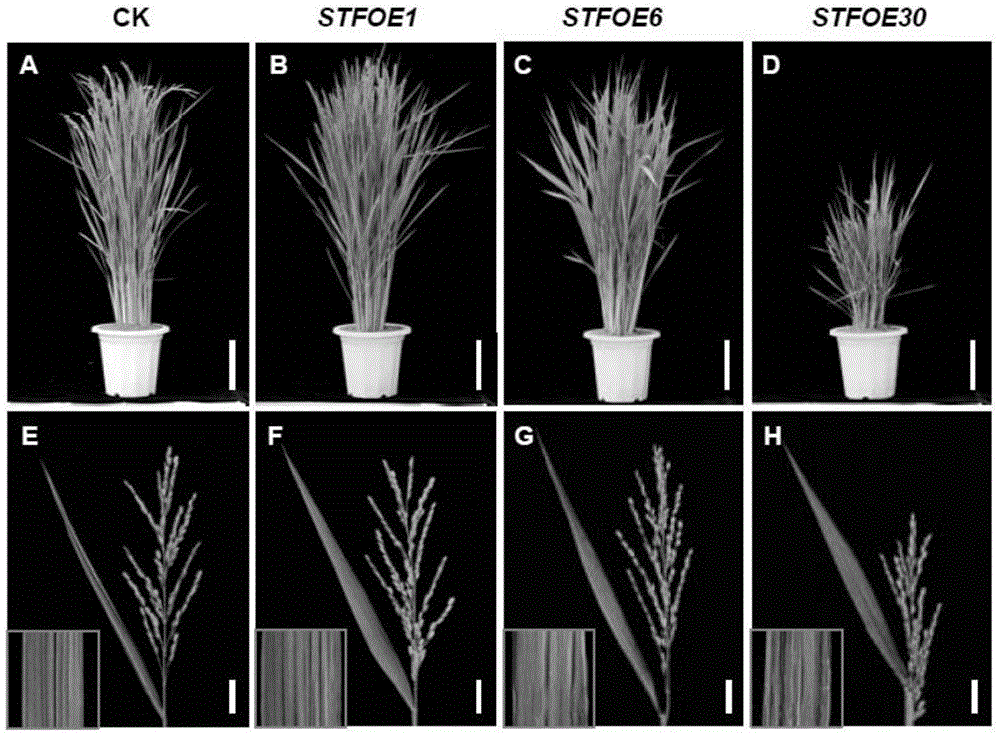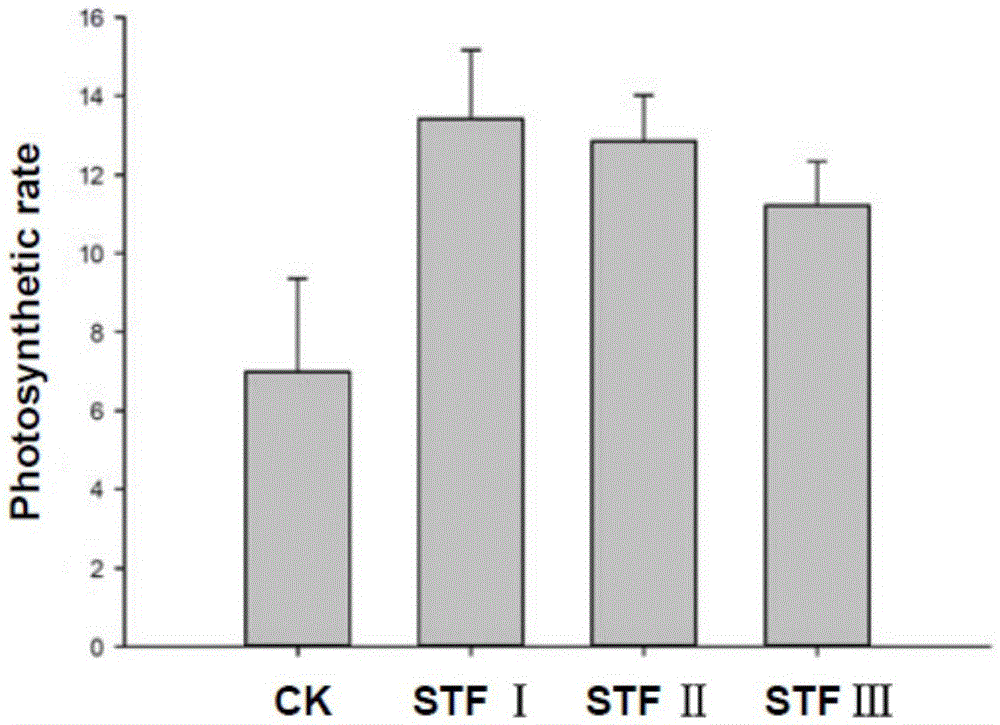Medicago truncatula leaf development regulatory gene STF, encoding protein and application of encoding protein
A technology for regulating protein and alfalfa, applied in application, genetic engineering, plant genetic improvement, etc., can solve problems such as limited understanding of molecular regulation mechanism, and achieve the effect of improving photosynthetic efficiency and lodging resistance
- Summary
- Abstract
- Description
- Claims
- Application Information
AI Technical Summary
Problems solved by technology
Method used
Image
Examples
Embodiment 1
[0024] The isolation clone of embodiment 1STF gene
[0025] The position of the CDS sequence of Medicago truncatula STF on the genome is Medtr8g107210, and PCR amplification primers were designed, forward primer F: 5'-ATGTGGATGGTGGGTTACAAT-3'; reverse primer R: 5'-TCAGTTTTTCAAGGGAAGAAACT-3'. Collect various tissue parts of Medicago truncatula at different growth stages, extract the total RNA of these materials by TRizol method (refer to invitrogentrizol), refer to invitrogenssRT-Ⅲ to reverse-transcribe the mRNA into cDNA, and use Medicago truncatula cDNA as a template to perform PCR to obtain the full sequence of STF. The reaction system is as follows:
[0026] The total PCR reaction system is 50 μL, including 1 μL of Medicago truncatula cDNA (50ng); 2.5 μL of dNTP (2.5 mM); 1 μL of primer F (10 μM); 1 μL of primer R (10 μM); Q5 (NEB) enzyme (5U / μL) 0.3 μL ; 10 μL of 5× buffer; ddH 2 O34 μL, a total of 50 μL. The PCR reaction program was: pre-denaturation at 94°C for 5min...
Embodiment 2
[0028] The acquisition of embodiment 2 transgenic rice of STF
[0029] According to the sequence information of STF, PCR amplification primers were designed at both ends of its CDS. Forward primer F: 5'-ggggacaagtttgtacaaaaaagcaggcttcATGTGGATGGTGGGTTACAAT-3'; reverse primer R: 5'-ggggacactttgtacaagaaagctgggtcctaTCAGTTTTTCAAGGGAAGAAACT-3'. Using the nucleotide sequence obtained in Example 1 as a template, PCR was performed to obtain the full sequence of STF (as shown in SEQ ID NO.2 in the sequence table).
[0030] The PCR product was ligated to the pDONR207 intermediate vector containing the Gateway linker by BP reaction, and the sequence identical to the target STF was identified by sequencing. Then STF-pDONR207 was recombined into the modified overexpression vector pMDC32-pUbi by LR reaction (the 35S promoter on the pMDC32 vector was replaced with the maize Ubiquitin promoter by enzyme digestion), and the vector Ubi::STF was obtained. The overexpression vector Ubi::STF was...
Embodiment 3
[0032] Example 3 STF gene functional analysis
[0033]According to the 30 STF rice transgenic plants obtained by the method of Example 2, these materials were planted into the field, and were divided into three categories according to the level of expression, and 3 representative transgenic plants were selected, and the leaves were treated at the seedling stage and mature heading stage respectively. Statistical analysis of panicle type and panicle type showed that the transgenic plants with moderate expression showed a phenotype of widened leaves, while the leaves of transgenic plants with excessive expression were severely curled (see attached figure 2 ). It was suggested that STF plays an important role in the process of altering rice leaf development. Select the control material and the STF overexpression transgenic material flag leaves at the booting stage, and use the photosynthetic efficiency meter LI6400xt to detect the photosynthetic efficiency of the control mater...
PUM
 Login to View More
Login to View More Abstract
Description
Claims
Application Information
 Login to View More
Login to View More - R&D
- Intellectual Property
- Life Sciences
- Materials
- Tech Scout
- Unparalleled Data Quality
- Higher Quality Content
- 60% Fewer Hallucinations
Browse by: Latest US Patents, China's latest patents, Technical Efficacy Thesaurus, Application Domain, Technology Topic, Popular Technical Reports.
© 2025 PatSnap. All rights reserved.Legal|Privacy policy|Modern Slavery Act Transparency Statement|Sitemap|About US| Contact US: help@patsnap.com



